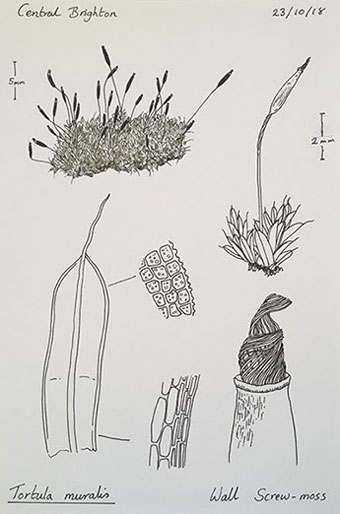


Tortula muralis (top) and map showing distribution of records below.
Photo: Brad Scott

Tortula muralis: Drawing showing habit and detail of capsule and leaf.
Drawing: Sue Rubinstein

Grimmia pulvinata (top) and map showing distribution of records below.
Photo: Brad Scott

Grimmia pulvinata: Drawing showing habit and detail of capsule and leaf.
Drawing: Sue Rubinstein
There are two very common mosses which grow on walls, tombstones, mortar and concrete, and so are easily observed in urban and suburban locations, yet which are remarkably under-recorded in Sussex.
The first, Tortula muralis, can be found in patches no more than 1cm tall, and is bright green when moist but dull, dark green when dry. It has tongue-shaped leaves 2-3mm long with a long white hair that extends from its tip. It has long narrow capsules held above the leaves, and when the cap is removed long twisted hair-like peristome teeth can be observed.
The second, Grimmia pulvinata, also has long silvery points to its leaves, and the two may grow together. However, Grimmia tends to form round cushions which look grey and furry due to the long hair points, and its leaves are much more drawn out. Its capsules are oval, and the seta ('stalk') on which they are borne tends to arch over when the plant is moist, though is erect when the capsule is old and dry.
There are many other species in both genera, though these two are by far the most common. They are both almost certainly in every tetrad in the county. We want to see how many records we can receive by the end of November, and especially how many new tetrad records there will be, so please have a look at your local walls. Please submit any records with some photos to iRecord, or with location, grid reference and date to @Trichocolea on Twitter, or by email to sue@rubinstein.plus.com.
There are regular field meetings recording the mosses and liverworts of the area organised by the South-East Group of the British Bryological Society, to which all are welcome, and you are encouraged to sign up to our email list. You can also follow the bryophyte recording activity in the county on our blog: https://sussexbryophytes.wordpress.com/bbs-se-group/
Every month it is our aim to highlight a species that is “in-season” and, although not necessarily rare or difficult to identify, has been highlighted by our local recording groups as being somewhat under-recorded and for which new records would therefore be welcomed.
If you or your recording group are aware of species such as this then please contact Bob Foreman.